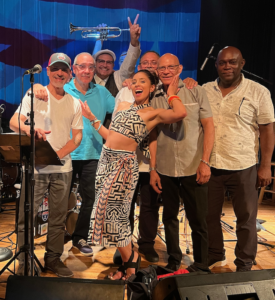Dancer and band team up to celebrate the islands
People often ask Christine Alicea if the term bomba y plena refers to a dance or a musical style from Puerto Rico.
It’s both — and more, she says, just as hip-hop serves as an umbrella for rap, graffiti and breakdancing.
“Bomba y plena dates to the colonial period and represents a melting pot,” Alicea says. “People expressed frustration, resilience and sorrow even as they celebrated life.”
Beyond a reverence for specific beats and lost-in-the-moment dancing, the rural folk style from the island’s Loiza region also includes “the storytelling, the rhythm of the drums and the preservation of a culture in danger of being lost,” she says.
On Saturday (July 27) at the Howland Cultural Center, the 36-year-old soul will perform a dance inspired by the ancients. Then, Cuboricua, a seven-piece band that specializes in classic Latin pop, takes the stage.
Alicea, who has lived in Beacon since 2011 but is struggling to stay as rents rise, has hosted salsa dances at the Howland. She immersed herself in island culture after her grandmother died in 2020.
The dancer is intent on passing the tradition to her 8-year-old daughter because “the music makes me feel so alive and makes my heart pump. It’s difficult to express my passion, joy and love for this style in words.”
The word plena also evokes a singer “spreading the news around the island, like it’s their newspaper,” she says. “I got into this with my heart and soul grieving, but it awakened my spirit as the ancestors passed the baton to me.”
Puerto Rico is no cultural island: Latin Caribbean music and dance styles ping-ponged between the larger landmasses of Cuba, the Dominican Republic and emigrants to New York City.
“They’re the same in many ways and I wanted to bring the experience into one spot,” she says. “The band delivers what I had envisioned.”
Its name, Cuboricua, blends Cuba and Boricua, a colloquial term for Puerto Rico. It also plays merengue, which is associated with the Dominican Republic.

Tony Velez, who performs the piano parts on a nine-string tres, a Cuban guitar, leads the band, which includes acoustic bass, timbales, conga drums, two trumpets and a singer. He calls it a C-7, short for a classic seven-piece group that pares a Latin big band to its essential parts.
The Howland show is billed as Salsa y Plena because the band focuses on what Velez called a golden age of Latin pop that drew from 1920s styles but forged a modern amalgam summarized by the imprecise, invented name salsa, or sauce in Spanish.
The style originated with Fania Records, co-founded in 1964 by Dominican flutist Johnnie Pacheco. The sound spilled from the New York City region back to the homelands. Called the Motown of Salsa, the label’s artists include Willie Colon, Ruben Blades, Ray Baretto, Gato Barbieri and Celia Cruz, known as the Queen of Salsa.
“Label reps went to Cuba, brought arrangements back to New York and modernized them,” says Velez. “They kept the groove and had a lot of hits from the ’50s to the ’70s when a big migration came to New York from Puerto Rico.”
Though generic terms such as salsa and mambo are convenient, Latin Caribbean music boils down to subtle rhythms such as son, rhumba, guajira and guaracha.
“It’s very specific, the beats and the song styles,” Velez says. “Bomba y plena is based on rhythms that originated in an Afro-Hispanic region with hand drums.”
The clave, a well-known cadence, comes in two major variations: 1-2 / 1-2-3 and 1-2-3 / 1-2. So serious are the beat police that crossing claves “is something you absolutely cannot do,” says Velez. “You’ll be docked pay for that.”
The Howland Cultural Center is located at 477 Main St. in Beacon. Tickets for the 7:30 p.m. show are $20 at bit.ly/salsayplena or for $25 at the door.



